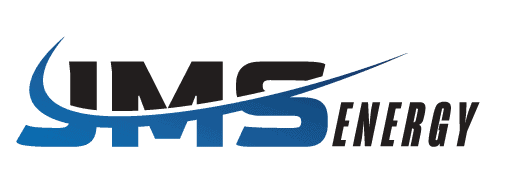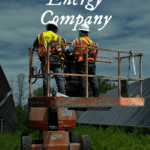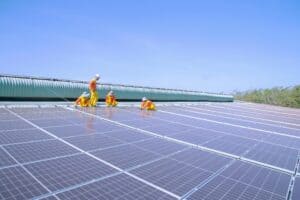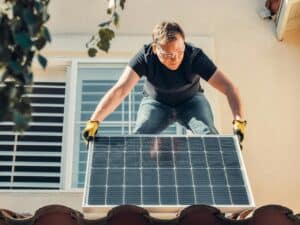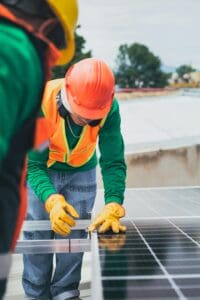
Table of Contents
Repowering is a term that has gained significant importance in the renewable energy sector, particularly in wind energy. It refers to the process of retrofitting and modernizing existing wind turbines with newer, more efficient technology to enhance performance and energy output. This concept plays a crucial role in the transition towards a more sustainable energy future, ensuring that existing wind farms continue to contribute effectively to energy needs while minimizing environmental impacts.

The Concept of Repowering
Repowering involves replacing old wind turbine components or entire turbines with new, advanced ones. This process can include upgrading the rotor blades, nacelles, and towers to newer models that are more efficient and capable of producing more electricity. By doing so, wind farms can increase their energy output without the need for additional land or new construction, making it a cost-effective and environmentally friendly option.
The Benefits of Repowering
- Increased Energy Production: One of the primary benefits of repowering is the significant increase in energy production. Modern turbines are far more efficient than those installed a decade or two ago. For instance, new turbines can generate more electricity even at lower wind speeds, maximizing the energy harvested from available wind resources.
- Enhanced Efficiency: Repowering allows for the integration of advanced technology and design improvements, leading to enhanced overall efficiency. This includes better aerodynamic designs, improved materials, and more sophisticated control systems that optimize turbine performance.
- Extended Lifespan: By upgrading existing wind turbines, the lifespan of the wind farm is extended. This ensures a longer period of energy generation and return on investment, providing financial stability for wind farm operators.
- Environmental Benefits: Repowering reduces the need for new wind farm construction, thus preserving natural landscapes and minimizing habitat disruption. It also ensures that the wind farm continues to operate at optimal capacity, reducing reliance on fossil fuels and lowering carbon emissions.
The Repowering Process
The process of repowering involves several steps, each crucial to ensuring the successful upgrade of existing wind turbines. These steps include:
- Assessment and Planning: The first step in repowering is a thorough assessment of the existing wind farm. This includes evaluating the condition of the turbines, their performance, and the potential for upgrading. Detailed planning is then carried out to determine the scope of the repowering project, including which components need to be replaced or upgraded.
- Permitting and Regulatory Approval: Repowering projects often require permits and regulatory approvals, similar to the construction of new wind farms. This ensures that the project complies with environmental regulations and land use policies.
- Component Replacement and Upgrades: The actual process of repowering involves replacing old components with new ones. This can range from simple upgrades like installing new rotor blades to complete overhauls involving the replacement of nacelles and towers.
- Testing and Commissioning: After the upgrades are completed, the new systems are thoroughly tested to ensure they operate correctly and efficiently. This step is crucial to identify any potential issues and ensure the upgraded turbines are ready for full-scale operation.
Case Studies in Repowering
Repowering has already been successfully implemented in various wind farms around the world. For instance, in Germany, the birthplace of the modern wind industry, repowering has played a significant role in maintaining and enhancing wind energy production. According to the BMWK, repowering in Germany has involved replacing older, smaller turbines with fewer, larger, and more powerful ones. This has resulted in a substantial increase in energy output without the need for additional land.
In the United States, the Department of Energy (DOE) has highlighted several successful repowering projects. These projects have demonstrated the potential for repowering to significantly boost energy production and efficiency. For example, repowering older wind farms in California with modern turbines has led to a threefold increase in energy output while reducing the number of turbines, thus minimizing environmental impact.
Challenges and Considerations
While repowering offers numerous benefits, it also comes with its own set of challenges and considerations:
- Financial Investment: Repowering requires significant financial investment. However, this investment is often justified by the increased energy production and extended lifespan of the wind farm. Financial incentives and support from governments can also play a crucial role in making repowering projects viable.
- Technical Challenges: Upgrading existing wind turbines can present technical challenges, particularly when it comes to integrating new components with older infrastructure. Detailed planning and engineering expertise are essential to overcome these challenges.
- Regulatory Hurdles: Securing permits and regulatory approvals for repowering projects can be time-consuming and complex. However, streamlined regulatory processes and support from policymakers can help facilitate these projects.
The Future of Repowering
As the demand for renewable energy continues to grow, repowering will play an increasingly important role in meeting energy needs. Advances in wind turbine technology will continue to make repowering more attractive, offering even greater efficiency and energy output.
Moreover, repowering aligns with global sustainability goals by ensuring that existing wind farms remain productive and environmentally friendly. It reduces the need for new land development and helps maintain the visual and ecological integrity of existing wind farm sites.
Conclusion
Repowering is a vital strategy in the renewable energy sector, offering a cost-effective and environmentally friendly way to enhance the performance of existing wind farms. By replacing old wind turbine components with new, advanced technology, repowering increases energy production, improves efficiency, and extends the lifespan of wind farms. Despite the challenges involved, the benefits of repowering make it a crucial component of the transition to a sustainable energy future.
For companies like JMS Energy, repowering represents an opportunity to lead the way in renewable energy innovation, ensuring that wind farms continue to contribute effectively to global energy needs while minimizing environmental impacts. As the technology and processes involved in repowering continue to evolve, it will remain a key strategy for maximizing the potential of wind energy and achieving long-term sustainability goals.
Frequently Asked Questions
What is repowering?
Repowering is the process of upgrading and modernizing existing wind turbines with newer, more efficient technology to enhance performance and energy output.
Why is repowering important?
Repowering is important because it increases energy production, improves efficiency, extends the lifespan of wind farms, and offers environmental benefits by reducing the need for new land development.
What are the steps involved in repowering?
The steps involved in repowering include assessment and planning, securing permits and regulatory approvals, replacing and upgrading components, and testing and commissioning the new systems.
What challenges are associated with repowering?
Challenges associated with repowering include financial investment, technical challenges in integrating new components with older infrastructure, and securing permits and regulatory approvals.
How does repowering contribute to sustainability?
Repowering contributes to sustainability by ensuring that existing wind farms remain productive and environmentally friendly, reducing reliance on fossil fuels and minimizing environmental impacts.
